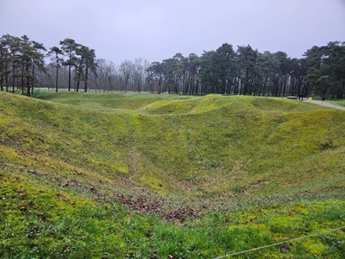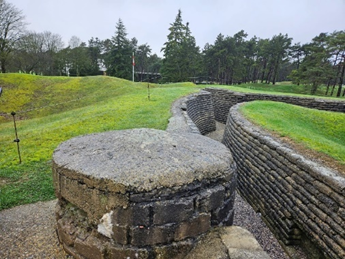On the morning of February 22, we got up, ate breakfast, took one
last trip through the Small Market of Arras, and then headed north to the City
of Ypres. On the way to Ypres we stopped at Vimy Ridge.
As long as I can remember, I have always heard about “The Battle of Vimy Ridge”, but it wasn’t until we went on this trip that I realized that most Americans haven’t heard of it. I now realize that while the battle of Vimy ridge was pivotal in the war and it was the battle that brought Canada to significance and gave them a seat at the planning table for how the war was prosecuted, it was just another ugly battle for most Americans who couldn’t tell you the name of any battle in World Ward One. It was the battle that brought the Canadians into their own.
Up until this point, Lisa, Alex and I were humbled and affected by the destruction of the battlegrounds but at Vimy Ridge, this became personal. This is the first battle that James Shaw fought. It was here that he first fired his gun at an enemy; and James had a big gun. He was a Lewis gunner and that also made him a big target for the enemy. As we walked the grounds around the memorial, we walked on the same ground that James walked on. They have a Canadian flag outside the visitors center and that is the exact spot where the troops mustered before they engaged the enemy. We stood exactly where James would have stood.
There were about 100,000 Canadians who fought at Vimy Ridge and 3,600 of them died in that battle. That means that James had a 3.6% chance of dying. That doesn’t seem too bad but I’d be really worried if someone told me that I had an a 1 in 30 chance of dying today. There were also 7,000 wounded so his odds of being wounded were 7%. The odds of being wounded or dying were over 10%. If he had 10 friends there with him, one of them was wounded or dead by the end of the battle.
Vimy Ridge was part of a larger plan of what was called the “Spring Offensive” that covered a large area along the front running from just north of the Belgium border near the coast, down through half of France towards Paris. The task of taking Vimy Ridge was given to the Canadians who up until now had been just a part of the British army. The Canadians were divided into four divisions and James was a part of the 3rd Division. This was the first time that all four of the Canadian Divisions fought together as a single entity.
In order to get closer to the German trenches, tunnels were dug up to just a few yards from where the Germans were located. We know exactly which tunnel the 3rd Division used to enter the battle. We were able to tour the very same tunnel that James used. Alex could be James except that James wouldn't have had to hunch over like Alex is doing.
At 5:30 in the morning, James ran down this tunnel and exited right next to these German trenches. The sand bags and the boards in the bottom of the trenches are concrete but the trenches are otherwise pretty much how they would have looked on the morning of April 9, 1917. They are the actual original trenches, just restored.
The Canadians led with a heavy artillery barrage just prior to the attack, and at 5:30 in the morning, during all the confusion, the Canadians rose out of the ground right next to these very trenches and attacked. This is a picture of one of the craters from a mine that had been placed under the German trench.
The French army had been trying to take Vimy Ridge for some time. It was a real problem for the Allies since it had such a commanding view of the entire area.
The British commander assigned Vimy Ridge to the Canadians. Lieutenant-General Sir Julian Byng, the guy in charge of the Canadians, drilled his troops endlessly so that every soldier knew his job perfectly. In most battles, the commanding officers are targeted by the enemy because when they fall the remaining troops fall into disarray. A big part of the Canadians success is that they knew their tasks so well that if their officer fell, they didn’t falter but continued to do their job.
We know exactly where James exited the tunnels, and he would have run up this very hill. The trees have grown since the battle, the original trees were completely obliterated, those shell holes would have been new and a lot more treacherous.
A big reason why the battle of Vimy Ridge is not well known outside of Canada is because the overall offensive failed, but Vimy Ridge was an amazing success. On April 12th, after four days of bloody battle and the loss of 10,000 solders, either killed or wounded, they took Vimy Ridge. One of the few battles to succeed and to the surprise of many. The Canadians suddenly had the admiration and respect of the entire offensive. They were now invited to the planning table.
The death toll would have been much worse, but the Canadians went to great lengths to save the lives of their wounded.
The memorial sits on top of Vimy Ridge and consists of two tall pillars which I’ve always thought was an odd memorial, but when you’re there it gives you a real sense of awe. It has several absolutely gorgeous statues spread around the memorial.










No comments:
Post a Comment